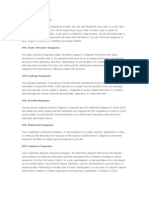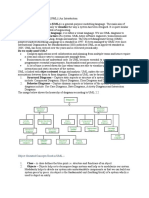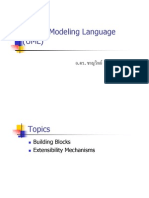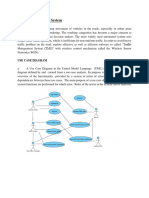0 ratings0% found this document useful (0 votes)
16 viewsRIS Section 2
RIS Section 2
Uploaded by
sohila abo ghanamUML diagrams can be categorized into structural diagrams and behavioral diagrams. The main UML diagram types are class, sequence, use case, activity, state machine, component, deployment, communication, package, object, composite structure, timing, and interaction overview diagrams. Class diagrams describe the static structure of a system by showing classes and relationships, while sequence diagrams illustrate the dynamic behavior by showing object interactions over time.
Copyright:
© All Rights Reserved
Available Formats
Download as PDF, TXT or read online from Scribd
RIS Section 2
RIS Section 2
Uploaded by
sohila abo ghanam0 ratings0% found this document useful (0 votes)
16 views8 pagesUML diagrams can be categorized into structural diagrams and behavioral diagrams. The main UML diagram types are class, sequence, use case, activity, state machine, component, deployment, communication, package, object, composite structure, timing, and interaction overview diagrams. Class diagrams describe the static structure of a system by showing classes and relationships, while sequence diagrams illustrate the dynamic behavior by showing object interactions over time.
Original Description:
Radiology
Original Title
RIS section 2
Copyright
© © All Rights Reserved
Available Formats
PDF, TXT or read online from Scribd
Share this document
Did you find this document useful?
Is this content inappropriate?
UML diagrams can be categorized into structural diagrams and behavioral diagrams. The main UML diagram types are class, sequence, use case, activity, state machine, component, deployment, communication, package, object, composite structure, timing, and interaction overview diagrams. Class diagrams describe the static structure of a system by showing classes and relationships, while sequence diagrams illustrate the dynamic behavior by showing object interactions over time.
Copyright:
© All Rights Reserved
Available Formats
Download as PDF, TXT or read online from Scribd
Download as pdf or txt
0 ratings0% found this document useful (0 votes)
16 views8 pagesRIS Section 2
RIS Section 2
Uploaded by
sohila abo ghanamUML diagrams can be categorized into structural diagrams and behavioral diagrams. The main UML diagram types are class, sequence, use case, activity, state machine, component, deployment, communication, package, object, composite structure, timing, and interaction overview diagrams. Class diagrams describe the static structure of a system by showing classes and relationships, while sequence diagrams illustrate the dynamic behavior by showing object interactions over time.
Copyright:
© All Rights Reserved
Available Formats
Download as PDF, TXT or read online from Scribd
Download as pdf or txt
You are on page 1of 8
What is a UML Diagram?
UML is a way of visualizing a software
program using a collection of diagrams.
These diagrams are organized into two
distinct groups:
structural diagrams and behavioral or
interaction diagrams.
Types of UML Diagrams
The current UML standards call for different
types of diagrams:
class, activity, object, use case, sequence,
package, state, component,
communication, composite structure,
interaction overview, timing, and
deployment.
Class Diagram
Class diagrams are the backbone of almost
every object-oriented method, including
UML. They describe the static structure of a
system.
Case Diagram Use
Use case diagrams model the functionality of
a system using actors and use cases
Diagram Activity
Activity diagrams illustrate the dynamic nature of a
system by modeling the flow of control from activity
to activity
Sequence Diagram
Sequence diagrams describe interactions
among classes in terms of an exchange of
.messages over time
Diagram Timing
A timing diagram is a type of behavioral or
interaction UML diagram that focuses on
processes that take place during a specific
.period of time
Diagram State
Statechart diagrams, now known as state
machine diagrams and state diagrams
describe the dynamic behavior of a system in
response to external stimuli.
Component Diagram
Component diagrams describe the
organization of physical software
components, including source code, run-time
executables. (binary) code, and
Diagram Deployment
Deployment diagrams depict the physical
resources in a system, including nodes,
components, and connections.
Communication Diagram
Communication diagrams model the
interactions between objects in sequence.
They describe both the static structure and
.the dynamic behavior of a system
Package Diagram
Package diagrams are a subset of class
diagrams, but developers sometimes treat
.them as a separate technique
Diagram Object
Object diagrams describe the static structure
of a system at a particular time. They can be
.used to test class diagrams for accuracy
Structure Diagram Composite
Composite structure diagrams show the
internal part of a class
Interaction Overview Diagram
Interaction overview diagrams are a
combination of activity and sequence
diagrams. They model a sequence of actions
and let you deconstruct more complex
.interactions into manageable occurrences
You might also like
- What Is UML?: Types of UML DiagramsDocument4 pagesWhat Is UML?: Types of UML DiagramsSoumen KanrarNo ratings yet
- UML DiagramDocument8 pagesUML Diagramsevandhi100% (1)
- Case ToolsDocument6 pagesCase ToolsSathyaPriya RamasamyNo ratings yet
- UNIT 1 - UML IntroDocument28 pagesUNIT 1 - UML IntroDEVIBALA SUBRAMANIANNo ratings yet
- Lect-20-21-UML - SW Engineering 1Document11 pagesLect-20-21-UML - SW Engineering 1Al YarNo ratings yet
- Activity DiagramDocument16 pagesActivity DiagramRonnie EdecNo ratings yet
- Diagrams in The UMLDocument14 pagesDiagrams in The UMLapi-26462544No ratings yet
- Software Engineering-Unit 4Document43 pagesSoftware Engineering-Unit 4anujacsNo ratings yet
- Se 3Document32 pagesSe 3ahmedshamil4567No ratings yet
- Chap IiDocument22 pagesChap Iivalo rantNo ratings yet
- UML DiagramsDocument7 pagesUML Diagramsguestblogger938No ratings yet
- UML DifferencesDocument11 pagesUML Differencessantanu mahalaNo ratings yet
- Use Case DiagramsDocument24 pagesUse Case DiagramsJigar ShahNo ratings yet
- ch-7 DiagramsDocument40 pagesch-7 DiagramsbhargaviNo ratings yet
- ProDocument3 pagesProFasil DaveNo ratings yet
- OO Analysis and Design and UMLDocument9 pagesOO Analysis and Design and UMLMayank SharmaNo ratings yet
- Behavioral UML Diagrams: 1) UML Use Case Diagram PurposeDocument8 pagesBehavioral UML Diagrams: 1) UML Use Case Diagram PurposeZahra QamarNo ratings yet
- Design Analysis: UML DiagramsDocument16 pagesDesign Analysis: UML DiagramsTejaNo ratings yet
- Biteranta - John Vincent - 2nd Year Bsit 1Document17 pagesBiteranta - John Vincent - 2nd Year Bsit 1api-619829083No ratings yet
- Unified Modeling Language: SpecifyingDocument12 pagesUnified Modeling Language: SpecifyingMounikaNo ratings yet
- Brief of UML Unit2Document12 pagesBrief of UML Unit2anmold652No ratings yet
- UML DiagramsDocument2 pagesUML Diagramssunnyprasad99No ratings yet
- CASE STUDyDocument20 pagesCASE STUDyTRAIL BLAZERNo ratings yet
- UML-lab RecordDocument122 pagesUML-lab RecordBavya Sri Sai100% (1)
- Unified Modeling LanguageDocument17 pagesUnified Modeling LanguageVikram ComputerInstituteNo ratings yet
- System Modeling Unit3 NotesDocument32 pagesSystem Modeling Unit3 NotesAmruta IngoleNo ratings yet
- Atm UmlDocument5 pagesAtm UmlRavi Shankar SinghNo ratings yet
- What Is UML? What're The Purposes of UML?: UML Use Case DiagramDocument4 pagesWhat Is UML? What're The Purposes of UML?: UML Use Case DiagramqwertyuiopNo ratings yet
- TALHA NADEEM 11610 CS 5thDocument15 pagesTALHA NADEEM 11610 CS 5thtalhanadeem02No ratings yet
- What Is UML?Document7 pagesWhat Is UML?ayushsingh.buiNo ratings yet
- Labmanual FullDocument97 pagesLabmanual FullSelva Kanmani67% (3)
- Chap2 - UMLDocument16 pagesChap2 - UMLvepowo LandryNo ratings yet
- 8-UML Building BlocksDocument23 pages8-UML Building BlocksPavandeep SainiNo ratings yet
- A UML Class Diagram Describes The Object and Information Structures Used by Your Application, Both Internally and in Communication With Its UsersDocument2 pagesA UML Class Diagram Describes The Object and Information Structures Used by Your Application, Both Internally and in Communication With Its UsersshettysonyNo ratings yet
- Structural Information, and The Other Seven Represent General Types of Behavior, Including Four ThatDocument3 pagesStructural Information, and The Other Seven Represent General Types of Behavior, Including Four ThatPrachi PriyamNo ratings yet
- Software Engineering: Topics: 1) Uml and Use-Case Diagram 2) Reverse Engineering 3) Rational RoseDocument12 pagesSoftware Engineering: Topics: 1) Uml and Use-Case Diagram 2) Reverse Engineering 3) Rational RoseM khawarNo ratings yet
- SEPM FileDocument44 pagesSEPM Fileaasthamahajan2003No ratings yet
- Unified Modeling LanguageDocument8 pagesUnified Modeling LanguageAswini Shankar SNo ratings yet
- Unit 5 System-ModelingDocument25 pagesUnit 5 System-ModelingMysto GanNo ratings yet
- App Dev Module 20 CopiesDocument8 pagesApp Dev Module 20 CopiesArjay BalberanNo ratings yet
- Unified Modeling Language (UML)Document84 pagesUnified Modeling Language (UML)Chanwit KaewkasiNo ratings yet
- Unit-3 - Software Design and UmlDocument87 pagesUnit-3 - Software Design and UmlpanwarpriyanshigenaiNo ratings yet
- UML Diagram Types Guide: Learn About All Types of UML Diagrams With ExamplesDocument27 pagesUML Diagram Types Guide: Learn About All Types of UML Diagrams With ExamplesBobby DebNo ratings yet
- Diagrams IntroductionDocument9 pagesDiagrams IntroductionHan JeeNo ratings yet
- UML DiagramsDocument4 pagesUML DiagramsprasanthNo ratings yet
- 2 Traffic Management SystemDocument7 pages2 Traffic Management SystemDurga PrasadNo ratings yet
- UML Lab ManualDocument56 pagesUML Lab ManualAnonymous M9NDXtI5dNo ratings yet
- What Are The Five Concepts of Object Oriented LanguageDocument3 pagesWhat Are The Five Concepts of Object Oriented LanguageSakthivel GovindarajNo ratings yet
- Diagrams IntroductionDocument8 pagesDiagrams IntroductionHan JeeNo ratings yet
- Class Diagram: Software Engineering Unified Modeling Language ClassesDocument1 pageClass Diagram: Software Engineering Unified Modeling Language ClassesHitesh DuaNo ratings yet
- Uml Lecture PDFDocument4 pagesUml Lecture PDFMuhammad MoizNo ratings yet
- Unit-V-MCA - MAI-204 SEM - UML - UML 2023Document27 pagesUnit-V-MCA - MAI-204 SEM - UML - UML 2023hv6131921No ratings yet
- OOAD Unit 5 - Traffic Management SystemDocument20 pagesOOAD Unit 5 - Traffic Management Systemlilooooooooooo100% (4)
- OOAD Unit 5 - Traffic Management SystemDocument20 pagesOOAD Unit 5 - Traffic Management SystemSowmya SNo ratings yet
- Lecture Notes 1.3.6Document13 pagesLecture Notes 1.3.6Ashutosh mishraNo ratings yet
- 01 - Introduction To UMLDocument52 pages01 - Introduction To UMLMB PillazoNo ratings yet



























































